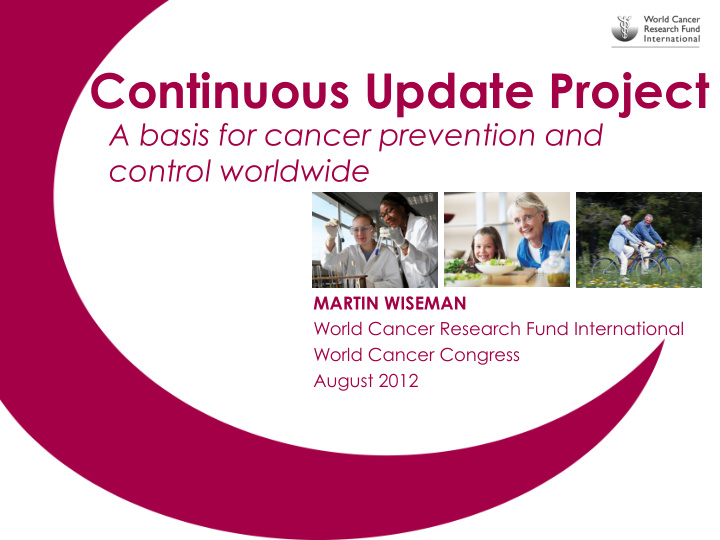



Continuous Update Project A basis for cancer prevention and control worldwide MARTIN WISEMAN World Cancer Research Fund International World Cancer Congress August 2012
Journal citations - WCRF/AICR Reports 500 450 400 350 Number of citations 300 Doll & Peto 1981 250 1997 EXPERT REPORT 2007 EXPERT REPORT 200 150 100 50 0 1997 1998 1999 2000 2001 2002 2003 2004 2005 2006 2007 2008 2009 2010 2011
Global variation in cancer incidence Breast Colorectum
Migration data
Around one third of the commonest cancers estimated avoidable through appropriate food, nutrition and physical activity
Number of papers from cohort studies by year and cancer type 200" 180" 160" 140" Number 120" 100" 80" 60" 40" 20" 0" 1980" 1982" 1984" 1986" 1988" 1990" 1992" 1994" 1996" 1998" 2000" 2002" 2004" 2006" 2008" 2010" Breast" Colorectum" Prostate" Pancreas" Endometrium" Ovary"
Everybody has a role to play Action needs to be coherent Leadership from Government Health professionals
Examples of 2007 WCRF/AICR Expert Report impact q Norwegian Dietary Guidelines q CRUK Prevention estimates
Novel aspects of CUP q Breast Cancer Survivors q Mechanisms
Novel aspects of CUP q Breast Cancer Survivors q Mechanisms
Inclusion criteria q Survivors of prim Survivors of primary bre ry breast c st canc ncer r q Food, nutrition, physic Food, nutrition, physical a l activity, nutrition- tivity, nutrition- re rela late ted c d com omple plementa ntary m ry medic dicine ine q R Random ndomise ised c d controlle ontrolled tria d trials ls • during a during and a nd afte fter the r thera rapy for prim py for primary bre ry breast st canc ncer r q Obse Observa rvationa tional studie l studies - s - exposure xposure a asse ssessm ssment nt • be before fore prim primary bre ry breast c st canc ncer dia r diagnosis gnosis (c (childhood, a hildhood, adole dolesc scenc nce, a , adulthood) dulthood) • at dia t diagnosis gnosis • during the during thera rapy py • afte fter the r thera rapy py
Outcomes q All-c ll-cause use m morta ortality lity q Bre reast c st canc ncer m r morta ortality lity q Se Second prim ond primary bre ry breast c st canc ncer r
Novel aspects of CUP q Breast Cancer Survivors q Mechanisms
29 MARCH 2012 | VOL 483 | NATURE | 531 S. GSCHMEISSNER/SPL Many landmark findings in preclinical oncology research are not reproducible, in part because of inadequate cell lines and animal models. Raise standards for preclinical cancer research C. Glenn Begley and Lee M. Ellis propose how methods, publications and incentives must change if patients are to benefit.
Mechanisms Protocol Development Group External Experts WCRF Team q Stephen Hursting (chair) q Martin Wiseman q Andrew Dannenberg q Susan Higginbotham q Johanna Lampe q Rachel Thompson q Henry Thompson q Rachel Marklew q Steven Clinton q Kate Allen q Nikki Ford - associate q Deirdre McGinley-Gieser member
Cancer: A Complex Process ✔ ✔ Dysregulated Inflammation growth signals and cellular energetics ✔ ✔ Genomic Evading instability growth suppression, apoptosis ✔ and immune surveillance Tissue ✔ invasion ∞ Sustained and angiogenesis metastasis ✔ Adapted from: Hanahan & Weinberg, Limitless replicative Cell (2000) and Cell (2011) potential
Revised IARC List of Mechanistic Targets (with Hanahan and Weinberg ) 1. Genomic instability 2. DNA damage/repair (specify) 3. Gene mutation (specify) 4. Epigenetic markers (specify) 5. Gene expression/miRNA changes (specify) 6. Serum hormones/growth factors (specify) 7. Urinary or tissue metabolite 8. Inflammation a. Cytokines (specify) b. Tissue markers (specify) c. Histological classification (specify) 9. Cell proliferation markers (specify) 10. Immunologic effects (specify) 11. Invasion/metastasis process (specify) 12. Angiogeneic effects (specify) 13. Cell signaling effects (specify) 14. Cell energetics effects (specify) 15. Differentiation (specify) 16. Cell death (apoptosis/autophagy/necrosis) 17. Replicative potential/ Stem cell enrichment Adapted from: IARC List of Mechanistic Targets
Mechanisms q Reviews to be systematic and peer reviewed q Reviews conducted by exposure q Pre-feasibility pilot q Feasibility test of final draft protocol by external group, including peer review q External review team should have expertise in informatics, stats, cancer biology, cancer site, nutrition
How to manage vast body of evidence q Consider limiting reviews to more recent publications when abundant evidence q Consider early exclusion of inappropriate models q Use informatics expert
Timeline
Conclusions q The 2007 WCRF/AICR Report remains the most authoritative review in the area q The CUP maintains the currency of the conclusions and recommendations q Together these provide a firm basis for public health and policy actions to prevent cancer, and other chronic diseases, worldwide
http://www.dietandcancerreport.org
Recommend
More recommend